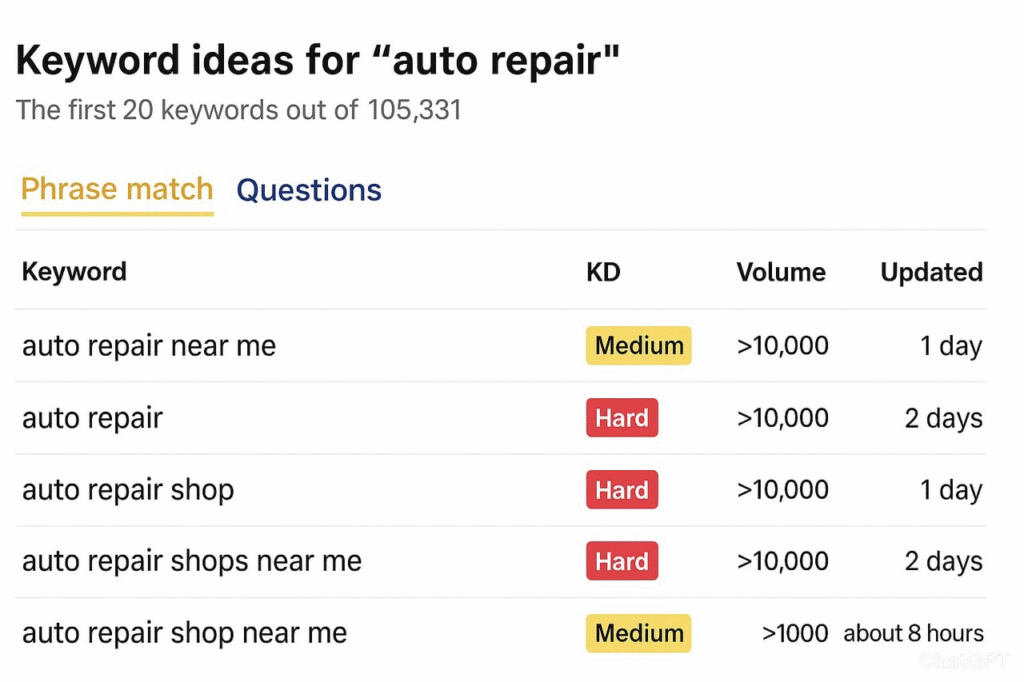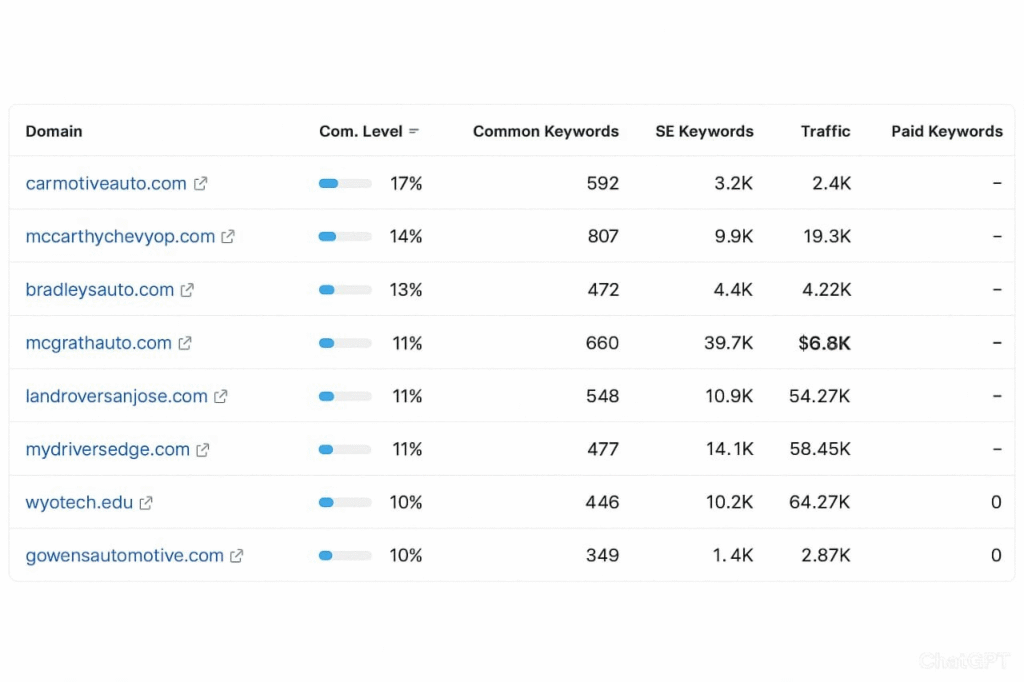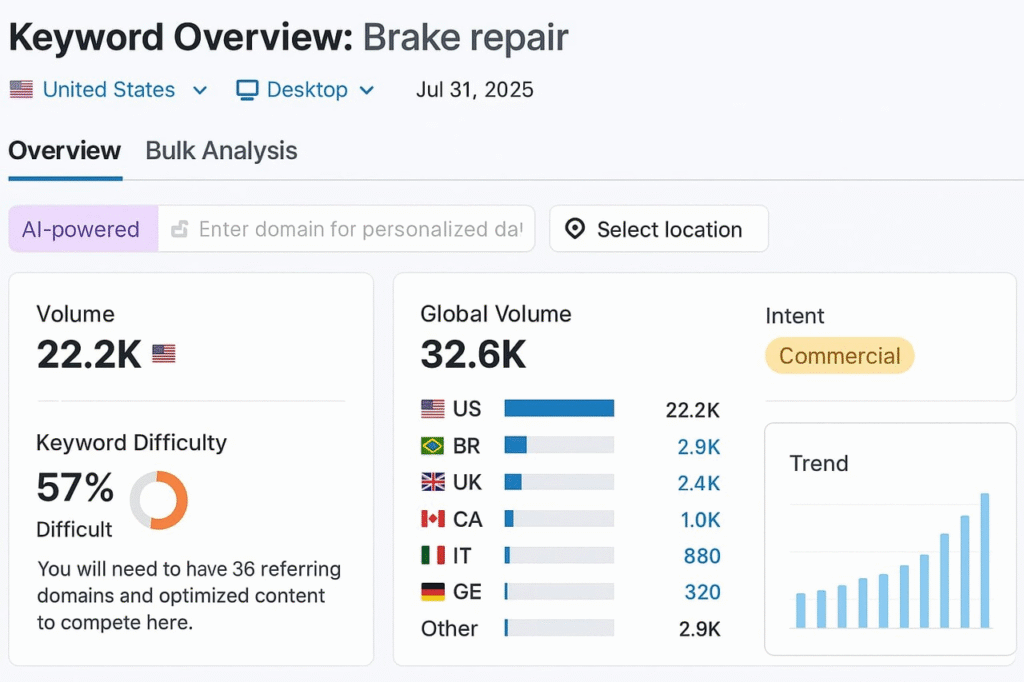Keyword research is the foundation of any successful SEO strategy and a core part of professional SEO services. It helps you understand what your audience is searching for, the terms they use, and how competitive those terms are. By identifying the right keywords, you can create content that drives traffic, ranks higher on Google, and attracts customers ready to convert. In this guide, we’ll walk you through a practical step-by-step approach to keyword research using real examples from The Maddex’s SEO services for their client, Eric’s Car Care in Houston.
Getting Started with Keyword Research
Before diving into tools and data, it’s essential to clarify your goals. Are you optimizing for local visibility, e-commerce sales, or blog traffic? For Eric’s Car Care, a Houston-based auto repair shop, the goal is to rank for location-specific services like “auto repair shop Houston” and “oil change near Medical Center.” Understanding your audience and their intent helps you find keywords that not only attract visitors but also lead to conversions.
Try Out Free Keyword Tools
Free keyword research tools like Google Keyword Planner, Ahrefs, and AnswerThePublic can give you valuable insights without cost. For example, searching “car AC repair Houston” might reveal monthly search volumes and related queries like “AC recharge near me.” These tools are perfect for small businesses starting out, providing a solid baseline of terms to target before investing in premium software.

See What Keywords Your Website Already Ranks For
Analyzing your current rankings helps you identify quick wins. Tools like Google Search Console and Semrush reveal which keywords already bring traffic to your site and where you rank on Google’s results. For Eric’s Car Care, discovering they rank #9 for “transmission repair Houston” means optimizing that page could quickly move them to the top three positions, driving more local leads.
See What Keywords Your Competitors Rank For
Competitor analysis uncovers opportunities you might be missing. By examining rivals like other Houston auto repair shops, you can see which keywords drive their traffic. If a competitor dominates “wheel alignment Houston,” but you haven’t optimized for it, this insight gives you a chance to create better content or a dedicated service page. Understanding gaps between you and competitors helps prioritize your SEO efforts strategically.

Study Your Niche
Studying your niche means looking beyond keywords to understand customer behavior and seasonal trends. For Eric’s Car Care, data shows spikes in searches for “AC repair Houston” during summer and “battery replacement Houston” during winter. Aligning content and promotions with these trends boosts relevance and traffic. The Maddex uses this insight to plan blogs, service pages, and ads tailored to the local Houston market.
Types of Keywords
Understanding keyword types helps you plan your SEO strategy more effectively. Keywords aren’t all the same; some are broad, some are highly specific, and others reflect different user intents. For Eric’s Car Care in Houston, combining these types allows The Maddex to target customers searching for general auto repairs as well as those ready to book a specific service.
Matching Terms
Matching terms are keywords closely related to your main service phrases, often containing slight variations or additional words. For example, if “brake repair” is your main keyword, matching terms could include “brake repair near me” or “affordable brake repair in Houston.” Optimizing for these variations ensures you capture a wider audience without diluting your main SEO focus.
Related Terms
Related terms are semantically connected keywords that help search engines understand your content’s context. For Eric’s Car Care, terms like “rotor replacement,” “brake fluid leak repair,” or “brake caliper repair” add depth to brake service content. These related phrases make your page more comprehensive and improve the chances of ranking for multiple search queries around the same topic.
Keyword Clusters
Keyword clusters involve grouping several related keywords into a single content strategy. Instead of creating separate pages for “car AC repair Houston” and “auto AC recharge,” you combine them into one strong, comprehensive page. This approach boosts relevance, reduces duplicate content, and targets multiple search terms at once, a key tactic The Maddex uses for Eric’s Car Care service pages.
Keyword Intents
Keyword intent reveals why someone is searching: informational (learning), navigational (finding a location), commercial (comparing), or transactional (ready to buy). For instance, “how to fix car AC” is informational, while “AC repair near Medical Center Houston” is transactional. Optimizing for intent ensures your content aligns with user needs and drives conversions for Eric’s Car Care’s services.

How to Prioritize and Apply Keywords
After collecting and grouping your keywords, the next step is deciding which ones to target first. Prioritization is crucial; focusing on the wrong keywords can waste time and budget, while the right ones drive immediate traffic and leads. For Eric’s Car Care, The Maddex uses metrics like search volume, difficulty, and relevance to determine which services (like brake repairs or AC servicing) to rank first.
Analyze Search Volume and Difficulty
Search volume shows how often people look for a keyword, while difficulty measures how competitive it is. High-volume, low-difficulty keywords, like “affordable oil change Houston”, are perfect starting points for new campaigns. The Maddex uses tools like Semrush to balance this data, ensuring Eric’s Car Care targets terms with achievable rankings and significant local demand.
Map Keywords to User Journey
Different keywords fit different stages of the buyer’s journey. Informational keywords like “how often should I change brake fluid” suit blog posts, while transactional ones like “brake repair shop near Rice Village” belong on service pages. By mapping each keyword to a specific stage, The Maddex creates a funnel that nurtures users from research to booking a repair appointment.
Optimize On-Page Placement
Where you place keywords matters. Primary keywords should appear in page titles, H1s, meta descriptions, and the first 100 words, while secondary keywords fit naturally in subheadings and supporting paragraphs. For Eric’s Car Care, The Maddex also ensures keywords are included in image alt text and internal links to maximize SEO impact.
Update and Refresh Regularly
Keyword trends shift over time. A term popular last year, like “cheap AC repair,” might now be less searched compared to “affordable auto AC service Houston.” The Maddex conducts quarterly audits for Eric’s Car Care, replacing outdated keywords and adding new ones to stay ahead of competitors and algorithm changes.
Ready to Turn Keywords into Customers? The Maddex Can Help
Finding the right keywords is just the first step; transforming them into traffic, leads, and loyal customers is where real growth happens. At The Maddex, we specialize in data-driven keyword research, on-page optimization, and content strategies that dominate local search results. Whether you run an auto repair shop like Eric’s Car Care or any service-based business, our team knows how to get you ranking faster and higher.
Want to see your business at the top of Google? Contact The Maddex today and let us build an SEO strategy tailored to your goals.



